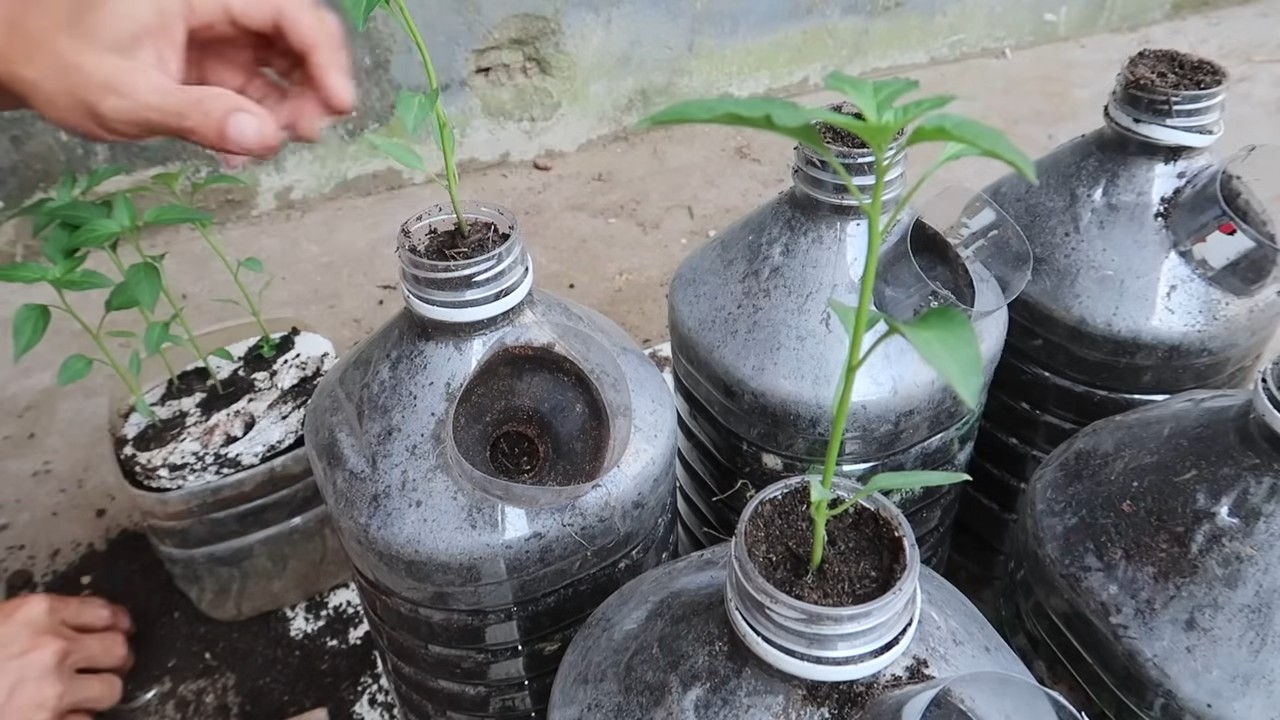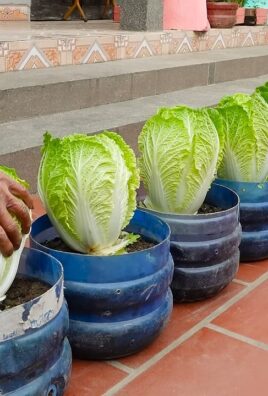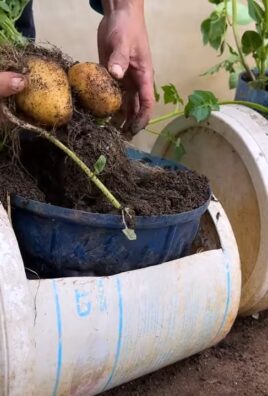Growing peppers in bottles might sound a little unconventional, but trust me, it’s a game-changer for any home gardener, especially if you’re short on space or just love a good DIY project! For centuries, resourceful gardeners have been finding innovative ways to cultivate their favorite plants, adapting to limited resources and urban environments. Think about the ancient hanging gardens of Babylon 鈥?a testament to human ingenuity in bringing nature into unexpected places.
But why should you consider growing peppers in bottles? Well, imagine harvesting a vibrant crop of spicy peppers right from your balcony or windowsill, even if you only have a tiny patch of sunlight. This method is perfect for apartment dwellers, beginner gardeners, or anyone looking to add a touch of green to their lives without breaking the bank. Plus, it’s a fantastic way to recycle those plastic bottles that might otherwise end up in a landfill.
In this article, I’m going to walk you through a simple, step-by-step guide to successfully growing peppers in bottles. We’ll cover everything from choosing the right bottle and soil to providing the perfect amount of sunlight and water. Get ready to unleash your inner gardener and enjoy the satisfaction of growing your own delicious peppers, one bottle at a time!

Growing Peppers in Bottles: A Fun and Space-Saving DIY Project
Hey there, fellow gardening enthusiasts! Are you short on space but dreaming of a bountiful pepper harvest? Well, I’ve got just the project for you: growing peppers in bottles! It’s a fantastic way to recycle, save space, and enjoy fresh, homegrown peppers. I’ve been doing this for a few seasons now, and I’m excited to share my secrets with you. Let’s get started!
What You’ll Need
Before we dive in, let’s gather our supplies. This is what I usually use:
* Plastic Bottles: The bigger, the better! I prefer 2-liter soda bottles or even larger water bottles. Make sure they’re clean and clear.
* Pepper Seeds or Seedlings: Choose your favorite pepper varieties! Bell peppers, jalapenos, habaneros 鈥?the choice is yours. I usually start with seedlings to get a head start.
* Potting Mix: A good quality potting mix is crucial for healthy pepper plants. Avoid using garden soil, as it can compact and hinder drainage.
* Scissors or Utility Knife: For cutting the bottles. Be careful!
* Drill or Nail: To create drainage holes.
* Water: Of course!
* Fertilizer: A balanced liquid fertilizer to feed your pepper plants.
* Optional:
* Gravel or small stones for drainage.
* Spray paint to decorate your bottles (make sure it’s safe for plants!).
* Labels to identify your pepper varieties.
Preparing the Bottles
This is a crucial step, so pay close attention. We need to transform those bottles into suitable homes for our pepper plants.
1. Clean the Bottles: Thoroughly wash the bottles with soap and water to remove any residue. Rinse them well and let them dry completely. This is important to prevent any contamination that could harm your plants.
2. Cut the Bottles: There are a couple of ways you can do this. I prefer cutting the bottle horizontally about two-thirds of the way up. This creates a larger planting area.
* Method 1 (Two-Part Planter): Cut the bottle completely in half. You’ll use the top half inverted as a sort of self-watering system (more on that later).
* Method 2 (Single Container): Cut the bottle about two-thirds of the way up, leaving the bottom portion intact. This is simpler, but you’ll need to be more diligent about watering.
3. Create Drainage Holes: This is absolutely essential! Peppers don’t like soggy roots. Use a drill or a nail to create several drainage holes in the bottom of the bottle. I usually make about 4-6 holes, depending on the size of the bottle. If you’re using the two-part planter method, you’ll also need to drill a small hole in the bottle cap to allow water to wick up.
4. (Optional) Decorate the Bottles: If you want to add a personal touch, now’s the time to decorate your bottles. You can use spray paint, markers, or even decoupage. Just make sure the materials you use are safe for plants and won’t leach harmful chemicals into the soil. Let the paint dry completely before moving on to the next step.
Planting Your Peppers
Now for the fun part! Let’s get those peppers planted.
1. Add Drainage Layer (Optional): If you’re using the single container method, you can add a layer of gravel or small stones to the bottom of the bottle to improve drainage. This isn’t strictly necessary, but it can help prevent root rot.
2. Fill with Potting Mix: Fill the bottle with potting mix, leaving about an inch or two of space at the top. Gently tap the bottle to settle the soil.
3. Plant Your Pepper Seedling: Carefully remove the pepper seedling from its container. Gently loosen the roots and place the seedling in the center of the bottle. Make sure the top of the root ball is level with the surrounding soil.
4. Fill in with Soil: Add more potting mix around the seedling, gently firming the soil.
5. Water Thoroughly: Water the newly planted pepper seedling thoroughly until water drains out of the drainage holes. This helps settle the soil and ensures the roots are well-hydrated.
6. (Two-Part Planter Method): If you’re using the two-part planter, invert the top half of the bottle (with the seedling planted inside) and place it inside the bottom half. Fill the bottom half with water. The water will wick up through the hole in the bottle cap, providing a constant source of moisture for the plant.
Caring for Your Pepper Plants
Now that your peppers are planted, it’s time to provide them with the care they need to thrive.
1. Sunlight: Peppers need plenty of sunlight to grow and produce fruit. Place your bottles in a location that receives at least 6-8 hours of direct sunlight per day. A south-facing window or a sunny balcony is ideal.
2. Watering: Water your pepper plants regularly, especially during hot weather. Check the soil moisture by sticking your finger into the soil. If the top inch feels dry, it’s time to water. Avoid overwatering, as this can lead to root rot. If you’re using the two-part planter method, replenish the water in the bottom half of the bottle as needed.
3. Fertilizing: Peppers are heavy feeders and benefit from regular fertilization. Use a balanced liquid fertilizer, following the instructions on the label. I usually fertilize my pepper plants every 2-3 weeks.
4. Support: As your pepper plants grow, they may need support to prevent them from toppling over. You can use stakes, bamboo skewers, or even tomato cages to provide support.
5. Pest Control: Keep an eye out for pests such as aphids, spider mites, and whiteflies. If you notice any pests, treat them promptly with insecticidal soap or neem oil.
6. Pollination: Peppers are self-pollinating, but you can help them along by gently shaking the plants or using a small brush to transfer pollen from one flower to another. This is especially important if you’re growing your peppers indoors.
Troubleshooting
Even with the best care, you might encounter some problems along the way. Here are a few common issues and how to address them:
* Yellowing Leaves: This can be caused by overwatering, underwatering, nutrient deficiencies, or pests. Check the soil moisture, fertilize your plants, and inspect them for pests.
* Blossom End Rot: This is a common problem in peppers, characterized by a dark, sunken spot on the bottom of the fruit. It’s usually caused by calcium deficiency. You can prevent blossom end rot by adding calcium to the soil or using a calcium-rich fertilizer.
* Lack of Fruit: This can be caused by insufficient sunlight, poor pollination, or nutrient deficiencies. Make sure your plants are getting enough sunlight, hand-pollinate the flowers, and fertilize your plants regularly.
* Stunted Growth: This can be caused by compacted soil, poor drainage, or root rot. Repot your plants in fresh potting mix and make sure the drainage is adequate.
Harvesting Your Peppers
The moment you’ve been waiting for! It’s time to harvest your peppers.
1. When to Harvest: The timing of the harvest depends on the pepper variety. Bell peppers are typically harvested when they’re fully colored and firm. Jalapenos are usually harvested when they’re green and about 2-3 inches long. Habaneros are harvested when they’re fully colored and have a slightly wrinkled appearance.
2. How to Harvest: Use a sharp knife or scissors to cut the peppers from the plant. Be careful not to damage the plant.
3. Enjoy Your Harvest: Now you can enjoy your fresh, homegrown peppers! Use them in your favorite recipes, share them with friends and family, or preserve them for later.
Tips for Success
Here are a few extra tips to help you succeed with growing peppers in bottles:
* Choose the Right Pepper Variety: Some pepper varieties are better suited for container gardening than others. Look for compact or dwarf varieties that won’t get too large.
* Use High-Quality Potting Mix: Don’t skimp on the potting mix! A good quality potting mix will provide your pepper plants with the nutrients they need to thrive.
* Provide Adequate Drainage: Drainage is crucial for preventing root rot. Make sure your bottles have plenty of drainage holes.
* Water Regularly: Peppers need consistent moisture, especially during hot weather.
* Fertilize Regularly: Peppers are heavy feeders and benefit from regular fertilization.
* Protect from Frost: Peppers are sensitive to frost. If you live in an area with cold winters, bring your bottles indoors

Conclusion
So, there you have it! Growing peppers in bottles isn’t just a quirky gardening experiment; it’s a genuinely effective and rewarding way to cultivate these vibrant vegetables, especially if you’re short on space or looking for a unique gardening project. We’ve walked you through the process, highlighting the benefits and addressing potential challenges. But why is this DIY trick a must-try?
Firstly, it’s incredibly space-efficient. Forget sprawling garden beds; a sunny balcony or patio is all you need. This makes it perfect for apartment dwellers, urban gardeners, or anyone with limited outdoor space. Secondly, bottle gardening offers excellent drainage and aeration, crucial for healthy pepper plant growth. The controlled environment also helps minimize soilborne diseases and pest infestations, giving your peppers a fighting chance. Thirdly, it’s a fantastic way to recycle plastic bottles, turning waste into a productive and beautiful mini-garden. You’re not just growing peppers; you’re contributing to a more sustainable lifestyle.
But the real magic lies in the control you have over the growing environment. You can easily move your bottle gardens to chase the sun or protect them from harsh weather. You can also tailor the soil mix to your specific pepper variety, ensuring they get the nutrients they need to thrive.
Ready to take your bottle gardening to the next level? Consider these variations:
* Vertical Pepper Garden: Stack multiple bottles vertically to create a stunning green wall. Use a sturdy frame to support the weight and ensure proper drainage for each bottle.
* Hydroponic Bottle Peppers: Experiment with a simple hydroponic setup using nutrient-rich water instead of soil. This can lead to faster growth and higher yields.
* Pepper Variety Showcase: Grow different pepper varieties in separate bottles to create a colorful and diverse display. Label each bottle clearly so you know what you are growing.
* Companion Planting in Bottles: Add companion plants like basil or marigolds to your bottle gardens to deter pests and attract beneficial insects.
Don’t be afraid to experiment and adapt the technique to suit your specific needs and preferences. The key is to have fun and learn along the way.
We are confident that once you try growing peppers in bottles, you’ll be amazed by the results. The satisfaction of harvesting your own homegrown peppers from recycled materials is truly unparalleled. It’s a simple, sustainable, and incredibly rewarding gardening experience.
So, grab some bottles, gather your supplies, and get started! We encourage you to share your experiences with us. Post pictures of your bottle gardens, share your tips and tricks, and let us know what pepper varieties you’re growing. Let’s create a community of bottle gardening enthusiasts and inspire others to embrace this innovative and eco-friendly approach to growing peppers. Happy gardening!
Frequently Asked Questions (FAQ)
What type of bottles are best for growing peppers?
The ideal bottles are clear or translucent plastic bottles, such as those used for water, soda, or juice. Avoid dark-colored bottles, as they can absorb too much heat and damage the roots. Two-liter bottles are a good starting point, but larger bottles can accommodate larger pepper varieties. Ensure the bottles are thoroughly cleaned before use to remove any residue that could harm your plants. Also, make sure the plastic is food-grade to avoid any harmful chemicals leaching into the soil.
What kind of soil should I use for growing peppers in bottles?
A well-draining potting mix is essential. You can use a commercially available potting mix or create your own by combining equal parts of peat moss, perlite, and vermiculite. Peppers prefer slightly acidic soil with a pH between 6.0 and 6.8. Consider adding compost or aged manure to enrich the soil and provide essential nutrients. Avoid using garden soil, as it can be too heavy and may contain pests or diseases.
How often should I water my pepper plants in bottles?
Watering frequency depends on the weather, the size of the bottle, and the type of pepper. Generally, water when the top inch of soil feels dry to the touch. Avoid overwatering, as this can lead to root rot. Ensure the bottle has adequate drainage holes to prevent water from pooling at the bottom. During hot weather, you may need to water daily. Check the soil moisture regularly and adjust your watering schedule accordingly.
How much sunlight do pepper plants need in bottles?
Pepper plants need at least 6-8 hours of direct sunlight per day to thrive. Place your bottle gardens in a sunny location, such as a south-facing balcony or patio. If you don’t have enough natural sunlight, you can supplement with grow lights. Rotate the bottles regularly to ensure all sides of the plant receive adequate sunlight. Insufficient sunlight can result in leggy growth and reduced pepper production.
How do I fertilize pepper plants growing in bottles?
Pepper plants are heavy feeders and require regular fertilization. Use a balanced fertilizer with an NPK ratio of 10-10-10 or 5-10-5. Start fertilizing a few weeks after transplanting the seedlings into the bottles. Follow the instructions on the fertilizer package for application rates. You can also use organic fertilizers, such as compost tea or fish emulsion. Avoid over-fertilizing, as this can burn the roots.
How do I protect my pepper plants from pests and diseases in bottles?
Bottle gardening can help minimize pest and disease problems, but it’s still important to take precautions. Regularly inspect your plants for signs of pests, such as aphids, spider mites, or whiteflies. Use insecticidal soap or neem oil to control infestations. Ensure good air circulation around the plants to prevent fungal diseases. Remove any diseased leaves or peppers promptly. Consider using companion plants, such as basil or marigolds, to deter pests.
Can I grow different varieties of peppers in bottles?
Yes, you can grow different varieties of peppers in bottles. However, it’s best to keep each variety in its own bottle to prevent cross-pollination. Label each bottle clearly so you know what you are growing. Consider the size and growth habits of each variety when choosing bottles. Smaller pepper varieties, such as chili peppers, are well-suited for smaller bottles, while larger varieties, such as bell peppers, may require larger bottles.
How do I transplant pepper seedlings into bottles?
Gently remove the pepper seedlings from their starter pots, being careful not to damage the roots. Dig a hole in the soil in the bottle that is large enough to accommodate the root ball. Place the seedling in the hole and gently backfill with soil. Water thoroughly after transplanting. Provide shade for the first few days to help the seedlings adjust to their new environment.
What do I do if my pepper plant outgrows the bottle?
If your pepper plant outgrows the bottle, you can transplant it into a larger container or directly into the ground. Choose a container that is at least twice the size of the original bottle. Gently remove the plant from the bottle, being careful not to damage the roots. Dig a hole in the new container or in the ground that is large enough to accommodate the root ball. Place the plant in the hole and gently backfill with soil. Water thoroughly after transplanting.
How long does it take to grow peppers in bottles?
The time it takes to grow peppers in bottles depends on the variety, the growing conditions, and the size of the plant. Generally, it takes about 60-90 days from transplanting to harvest. Provide adequate sunlight, water, and nutrients to promote healthy growth and faster pepper production. Be patient and enjoy the process of watching your pepper plants grow and produce delicious peppers.





Leave a Comment